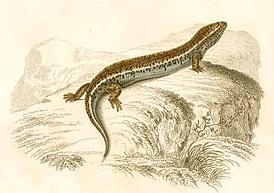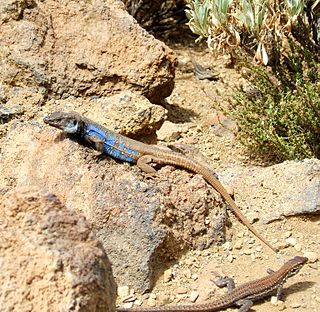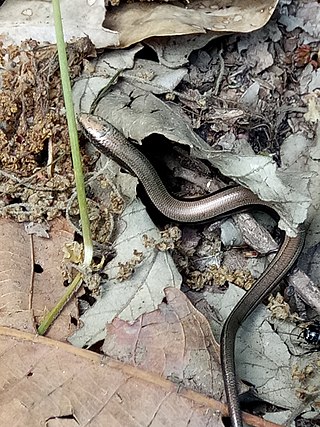
The common chaffinch or simply the chaffinch is a common and widespread small passerine bird in the finch family. The male is brightly coloured with a blue-grey cap and rust-red underparts. The female is more subdued in colouring, but both sexes have two contrasting white wing bars and white sides to the tail. The male bird has a strong voice and sings from exposed perches to attract a mate.

Dibamidae or blind skinks is a family of lizards characterized by their elongated cylindrical body and an apparent lack of limbs. Female dibamids are entirely limbless and the males retain small flap-like hind limbs, which they use to grip their partner during mating. They have a rigidly fused skull, lack pterygoid teeth and external ears. Their eyes are greatly reduced, and covered with a scale.

Chalcides is a genus of skinks.

The prickly skink, or prickly forest skink, is a morphologically and genetically distinctive species of skink endemic to rainforests of the Wet Tropics of Queensland World Heritage Area, in north-eastern Australia. Unlike most small skinks, which have smooth scales, this species has rough, ridged and pointed scales. These keeled scales may be an adaptation to its high-rainfall habitat, to its microhabitat in rotting logs, or to camouflage it when moving through forest leaf-litter.

Chioninia coctei is an extinct species of lizard that was at one time known to inhabit the islets of Branco and Raso in the Cape Verde islands of the Atlantic Ocean, islets rendered deserts by human-caused habitat destruction. None has been observed since the early 20th century, and the species was officially declared extinct in 2013.

The genus Gallotia are the lacertids of the Canary Islands. This genus consists of a group that has been evolving there ever since the first islands emerged from the sea over 20 million years ago. The endemic species and subspecies of this group have a number of characteristics that make them quite special within their family (Lacertidae); their only close relatives are the sandrunner lizards (Psammodromus) of the western Mediterranean region. Gallotia are characteristic for eating significant quantities of plants, and several lineages are often presented as classic examples for insular gigantism. However, a find of an even larger Gallotia species from the early Miocene of mainland Europe casts doubt on this assumption. Instead the ancestor of all modern Gallotia species of the Canary islands was probably already very large but carnivorous.

Gallotia galloti is a species of wall lizard in genus Gallotia. It is endemic to the Canary Islands of Tenerife and La Palma. Unlike most larger species of its genus, G. galloti is a common animal.

The Algerian three-toed skink is a species of "grass-swimming" skink with an elongated serpentine shape and reduced limbs. It is endemic to north-western Africa.

The Fuerteventura skink is a species of skink in the family Scincidae. Skinks are lizards belonging to the family Scincidae, a family in the infraorder Scincomorpha.

The West Canary skink, also known commonly as the Canaryan cylindrical skink, East Canary Islands skink, the Tenerife skink, is a species of lizard in the family Scincidae. The species is endemic to the Canary Islands.

The Gran Canaria giant lizard is a species of lizard in the family Lacertidae. The species is found in the Canary Islands.

The Iberian worm lizard, Mediterranean worm lizard, or European worm lizard is a species of reptile in the family Blanidae of the clade Amphisbaenia. The Iberian worm lizard is locally known as cobra-cega (Portuguese), culebrilla ciega (Spanish), and colobreta cega (Catalan), all meaning "blind snake". Recent studies into the mitochondrial and nuclear genomic data of 47 isolated B. cinereus populations show rather large sequence divergence between two apparent clades, leading some researchers to call for a division of the Iberian worm lizard into two species. While little is known of B. cinereus in comparison with some other reptile species, new insight is growing about this primitive, ancestral reptile.

Chalcides ocellatus, or the ocellated skink is a species of skink found in Greece, southern Italy, Malta, Lebanon, and parts of northern Africa. UAE, Israel, It is also found in Pakistan, India and Sri Lanka.

The eastern three-lined skink, also known commonly as the bold-striped cool-skink, is a species of skink, a lizard in the family Scincidae. The species is endemic to Australia. A. duperreyi has been extensively studied in the context of understanding the evolution of learning, viviparity in lizards, and temperature- and genetic-sex determination. A. duperreyi is classified as a species of "Least Concern" by the IUCN.

Eulamprus quoyii, more commonly known as the eastern water skink, eastern water-skink, or golden water skink, is a viviparous species of diurnal skink. Eulamprus quoyii belongs to the family Scincidae and is considered a common garden animal in Australia. The skink is endemic to Australia and found only along the east coast of the country. It makes its home in creekside habitats along the east coast of Australia and in urban garden areas with high amounts of moisture. The species can be identified by the twin, long yellow stripes that run along its body from the top of the eye, as well as by several more specific character derived states. The pale yellow dorsolateral stripes are most likely where its common name, the golden water skink, is derived. Like other ectotherms, the skink can often be seen basking in the sun on rocky outcroppings in order to regulate its body temperature. Its diet mainly consists of both aquatic and terrestrial insects, tadpoles and small amounts of plant matter. The skink both hunts for food and scavenges when necessary and is considered an opportunistic feeder. It is prey to larger lizards, snakes, cats and birds and so will often be seen moving quickly into hiding when other organisms are present.

Anolis oculatus, the Dominica anole, Dominican anole, eyed anole or zandoli, is a species of anole lizard. It is endemic to the Caribbean island of Dominica, where it is found in most environments. The species is found in a diverse range of color forms, which one herpetologist once classified as four subspecies, which most other scientists did not recognise because the forms gradually inter-grade with one another. Two later researchers have instead promoted the "ecotypes" concept, hypothesizing the color forms are maintained by the ecological conditions of the surrounding environment, despite being genetically indistinguishable. The morphology of some traits is subject to clinal variation, gradually changing from one side of the island to the other, or from sea level to the hilltops. The ground color ranges from pale tan or yellow to deep green or brown. It also has patterned markings that range from light-colored speckling to complex marbled patterns, and some populations also have large black-ringed "eye" spots on their flanks.

Saiphos equalis, commonly known as the yellow-bellied three-toed skink or simply three-toed skink, is a species of burrowing skink found in eastern Australia. It is the only species classified under the genus Saiphos.

Leonhardi's ctenotus, Leonhardi's skink, or common desert ctenotus is a species of skink found in a range of arid and semi-arid regions throughout mainland Australia. The species was named after German anthropologist Moritz von Leonhardi in 1919 and belongs to the Ctenotus genus, one of the largest genera of lizards in Australia.




















